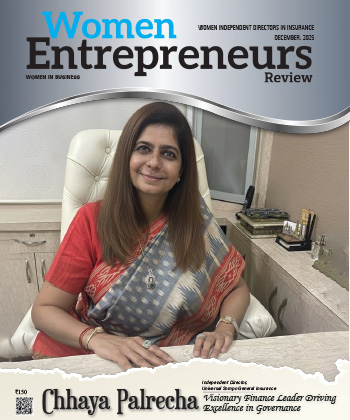
How Tata AIA is Empowering Women with Insurance That Understands Their Needs
By: Gayatri Nathan, Chief Compliance Officer, Tata AIA Life Insurance
Gayatri Nathan brings over 24 years of life insurance expertise spanning compliance, operations, and consumer experience. A Six Sigma Master Black Belt, she is recognized for driving transformation, digital innovation, and advancing customer-centric strategies across leading insurance organizations.
In an insightful interaction with Women Entrepreneurs Review Magazine, Gayatri shares her perspective on reshaping life insurance to better serve women’s growing financial roles, highlighting systemic shifts and leadership influence needed to bridge the protection gap and foster inclusivity.
It’s commonly believed that life insurance policies are designed with male consumers in mind. With women increasingly stepping into financial roles, don’t you think it’s time for a change?
Yes, it’s time to refresh our thoughts on this subject. Historically, men have been viewed as the primary breadwinners, resulting in a focus on their financial security. However, times have drastically changed. Women today are not only contributing equally but, in many cases, are also the primary earners or co-breadwinners in their families. They are balancing careers, caregiving, and managing multiple financial responsibilities. Yet, many insurance products still fail to address the unique needs of women—whether it’s maternity benefits, career breaks, or multi-generational care responsibilities.
The time has undoubtedly come to shift this paradigm. Women’s financial needs and life stages are distinct, and insurance products must evolve to reflect these realities. The future of life insurance must reflect the evolving roles of women in the workforce and society, ensuring that their needs are met with the same level of understanding and support. Life insurance should be a tool of empowerment, not just a safety net for men. So, this change isn’t just necessary; it’s overdue.
From your perspective, what shifts either systemic or industry-wide are needed to ensure that life insurance products truly reflect and support women’s financial independence?
Millions of women across India are juggling careers, managing households, raising children, and caring for ageing parents yet, while they plan for their children’s education, save for a dream home, or support their parents’ healthcare, many overlook one crucial question: “If something were to happen to me tomorrow, would my family be financially secure?” For too many, the answer is no.
That’s why it’s critical for women who are building their families’ dreams also to protect them. At the same time, life insurance can no longer follow a one-size-fits-all model. It’s time for the industry to develop insurance products that reflect women’s evolving needs. By designing policies that cater to women’s unique circumstances, offering flexible coverage, maternity benefits, and financial security for family caregivers, we create more inclusive and relevant solutions.
That’s why at Tata AIA, we have designed a women-centric term plan with these realities in mind. Our latest product, Tata AIA Shubh Shakti, represents the Positive and Protective energy that empowers women to overcome life's challenges. It’s more than just a protection plan; it’s about giving today’s women the means to secure their children’s education, care for ageing parents, support their partners, and build a future free from worries. We’ve crafted it to help women keep thriving, with the peace of mind that their loved ones are protected.
With the launch of Tata AIA Health Buddy, how do you see digital wellness solutions complementing traditional life insurance, especially for women balancing health, family, and work?
We believe that protecting lives goes beyond just financial security; it’s about being there for our customers in every moment that truly matters. That’s why we introduced Tata AIA Health Buddy, India’s first 24/7 wellness companion from a life insurer, blending health, wellness, and life insurance in an entirely new way.
Health Buddy is more than just a wellness service; it’s a holistic approach to our consumers’ overall well-being. By combining personalised health services with the peace of mind that comes with life insurance, we aim to support not only our consumers’ families during critical times but also throughout their journey toward living healthier lives.
With Health Buddy, we’re offering much more than a traditional insurance plan—it’s a lasting partnership that adapts to our consumers’ needs. From preventative care to critical health management, Tata AIA’s Health Buddy ensures you’re supported at every step, empowering you to stay well with periodic health checkups and be ready for whatever life brings.
Also, the benefits of Tata AIA Health Buddy are included in our women-specific term solution, Shubh Shakti. When women consumers buy Shubh Shakti, they not only secure their financial future but also benefit their loved ones. This plan offers Health & Wellness support, ensuring that the well-being of the policyholder’s family is also prioritised. Alongside coverage, Shubh Shakti provides personalised lifestyle nudges, including diet recommendations, activity goals, and rewards for achieving them.
Based on your experience at Tata AIA, what behavioural patterns or myths still hold women back from investing in life insurance? How can compliance contribute to breaking down those barriers?
A persistent behavioural pattern holding women back from investing in life insurance is the long-standing myth that it’s only necessary for the primary breadwinner, typically assumed to be male. This outdated perception often sidelines women’s own need for financial protection, even as they contribute significantly, financially and otherwise, to their households. Many women instinctively prioritise their family’s needs but overlook securing themselves, which can leave dependents vulnerable in the long term.
At Tata AIA, we’ve seen that when women are offered solutions that genuinely reflect their life journeys, such as coverage that supports maternity, childcare, or career breaks, they respond with strong engagement. Clear, respectful, and inclusive communication, guided by compliance, is key. Moving away from stereotypical messaging allows women to see life insurance as not just necessary, but empowering—enabling smarter, more confident financial decisions.
How do you see regulatory frameworks evolving to better address the changing financial protection needs of today’s working women, especially as they progress through different career and life stages?
Financial literacy remains a significant challenge for many Indians, particularly amongst women. A Tata AIA survey found that 89 percent of married women leave financial planning to their husbands, with only 44 percent taking independent financial decisions. Even among working women, insurance ownership remains low, leaving families vulnerable in the event of an illness, accident, or loss of life. This often forces families to dip into savings or take loans to maintain their standard of living.
Often, the lack of awareness about financial protection leaves many Indian women financially vulnerable. A powerful yet underutilized provision that addresses this is the Married Women’s Property Act (MWPA) of 1874. When a life insurance policy is purchased under the MWPA, the benefits are legally protected. They can only be claimed by the insured’s wife and children—shielding them from creditors and legal liabilities. This simple step transforms life insurance into a strong, legally enforceable tool for securing a family’s long-term financial future, yet it remains overlooked due to limited public awareness.
The Insurance Regulatory and Development Authority of India (IRDAI) is spearheading educational initiatives aimed at promoting financial literacy, enabling women to understand insurance products and long-term financial planning better. As awareness about the importance of insurance grows, Indian women will be able to make informed decisions about their financial futures, creating a stronger safety net for their families.
How can women leaders in compliance, legal, and governance influence a more inclusive approach to insurance—one that helps close the protection gap for women customers?
I feel women in compliance, legal, and governance roles bring a unique and invaluable perspective to the table. They can translate complex regulations into actionable, empathetic, and accountable solutions that resonate with customers, ensuring that fairness is not only enforced but genuinely felt. At Tata AIA, we advocate for simpler, more transparent policy structures, clearer communication, and a deeper understanding of the various life stages that women experience. This helps us design more accessible products and create processes that address the protection gaps many women face. We aim to do more than uphold regulatory standards; we actively work to shape them, ensuring that insurance becomes a tool for inclusion. We endeavour to make our offerings not only legally sound but also human-centred and equitable, ultimately making insurance more accessible, less complex, and meaningful for all.
Most Viewed
- 1 Women's Health Startup HerMD Closing Doors Amid Industry Challenges
- 2 5 Famous Women in Indian Armed Forces
- 3 Saudi Women No longer Require Male Permission for Clothing Choices, says Prince MbS
- 4 Kolkata Medtech Startup Innovodigm Raises Rs 5.5 Crore Seed Funding Led by IAN Group
- 5 Yamunanagar's Kashish Kalra Honoured after Securing 111th Rank in UPSC Civil Services Exam
- 6 Madurai Appoints Its First Woman Corporation Head
- 7 IAS Vijayalakshmi Bidari Appointed as the new Nagpur Divisional Commissioner
- 8 American Entrepreneur Lucy Guo Overtakes T Swift to become Youngest Female Billionaire
- 9 ICC Women's World Cup 2025 Trophy Showcased at Indore's Holkar Stadium
- 10 Aparna Saxena's Beauty Venture AntiNorm Launches in India
- 11 Vidya Nataraj Co-Founded BlueStone Jewellery & Lifestyle files IPO
- 12 5 Women Freedom Fighters of India
- 13 Dr. G Krishnapriya appointed as CEO for Trichy
- 14 M3M & Sirona Partner to Introduce Menstrual Hygiene Vending Machines in 15 Locations
- 15 Punjab Govt launches SHE Cohort 3.0 Supporting Tech-led Women Startups
- 16 Indian origin Lawyer, Sweena Pannu appointed as the US New Superior Court Judge
- 17 The Aurora Tech Award recognizes 4 Indian Women-led Startups
- 18 Kerala's Republic Day parade featured an all-female tableau
- 19 Manisha Kabbur Becomes Karnataka's First Woman International Karate Coach
- 20 Director K. S. Ravikumar's Daughter Maalica Ravikumar Launches Life Coaching Company 'Evergrowth Academy' for Women
- 21 Leezu's Raises Pre-Seed Funding to Accelerate Growth in Sexual Wellness Industry
- 22 Sattu: Super-easy summer drink for PCOS gut healing
- 23 Swathi Nelabhatla creates Sitha App, India's First Women-Exclusive Gig Platform
- 24 7 Timeless Female Kathak Dancers & their Iconic Legacies
- 25 Meet 7 Iconic Women Architects of Modern India & their Most Impactful Work
- 26 This Woman-led Insuretech Startup is Helping Bridge the Education Financing Gap in India
- 27 Women Leaders Share Lessons Learnt from India Women's WC Win
- 28 5 Enterprising Women Founders Powering Singapore's Tech & Innovation Landscape
- 29 4 Women. 4 Stories. One Vision for Smarter, Stronger Healthcare
- 30 Global Gender Gap Narrows to 68.8%, But Full Equality 123 Years Away: WEF Report 2025
- 31 Changemakers: 7 Women Entrepreneurs Taking the Make in India Movement Forward
- 32 Meet Lucy Guo, The Youngest Self-Made Female Billionaire Disrupting Tech
- 33 How Women are Driving India's Festive Online Shopping Surge






